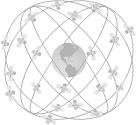Chapter 9. Global Positioning System (GPS)
Have you ever lost your way when you were in a foreign country, state, or even your neighborhood? You could use a map to help orient yourself. But if you are in a foreign land, this is not always an easy task.
This is where the Global Positioning System (GPS) comes in. Using GPS, you can find out precisely where you are on earth, and, when equipped with the appropriate mapping software, you can get driving instructions to bring you to your destination.
In this chapter, I explain how GPS works and how you can equip your Windows XP notebook with a GPS receiver and mapping software. We will go driving with our GPS and even have a little Wi-Fi fun!!
How GPS Works
The Global Positioning System consists of 27 earth-orbiting satellites (of which 24 are operational and 3 are backups) circling the earth twice each day. These satellites are arranged in six orbital paths, as shown in Figure 9-1.

Figure 9-1. Satellites circling the earth in six orbital paths
These satellites continuously emit coded positional and timing information using low-power radio waves at frequencies in the 1500 MHz range. GPS receivers on earth then pick up the signals and calculate the exact[1] positioning on earth. The orbits of the satellites are arranged in such a manner that at any one time, four satellites are visible. Thus, a GPS receiver is able to receive signals from these ...
Get Windows XP Unwired now with the O’Reilly learning platform.
O’Reilly members experience books, live events, courses curated by job role, and more from O’Reilly and nearly 200 top publishers.

